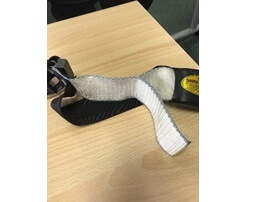[Chapter 3] Section 8 ④
3.Accident examples and countermeasures③
- [Example 6]
Worker fell from the working floor to the ground, together with the scaffolding member, during scaffolding dismantling work following completion of construction. -
[Accident situation]
The site of the accident was a construction site for a three-story reinforced concrete apartment building owned by the company.
Although scaffolding was installed around the building, the main building construction had already been finished, and dismantling of scaffolding was being carried out by 7 workers from the company when the accident occurred. The scaffolding was assembled using steel pipes, steel pipe standard forms, braces, etc. In terms of method, the scaffolding was disassembled from the upper part, and the members were passed down by hand at the beginning, but dropped starting midway through the process.
The victim was carrying out this work as a 2-person team with the site manager. The standard forms of the fourth stage of scaffolding from the bottom were removed one by one, and while attempting to drop one, the worker fell together with the standard form to the ground 5.8 m below.
The victim was wearing a safety helmet, but was not wearing any fall arrest equipment and had not brought it to the site.
In addition, there was one person with qualifications as an operation chief at the site, but that person had not been appointed, and was not directing the work.
[Cause]
1) Measures had not been taken to prevent falling of workers engaged in dismantling.
2) No specific work procedure had been indicated for carrying out the dismantling work.
3) The operation chief had not been appointed and was not directly supervising the work.
[Countermeasures]
1) Decide on specific fall prevention measures to be used during dismantling work and have an operations chief monitor implementation of the measures, and use of protective equipment, etc.
2) Examine effective fall prevention measures for each stage of dismantling work and ensure all workers consistently implement them.
3) Appoint an operations chief and have him supervise the work directly.
[Reference] Intuitive understanding and actual calculation formula
★If a person falls from a height of 5 meters…
(Gravitational acceleration g = 9.8 m/s2, assuming no air resistance)
・Fall time ➡ 1.01 seconds [t (Time) = √ (2 h/g)]
・Speed at the time of impact ➡ 9.9 m/s (35.64 km/h) [v (velocity) = √ (2gh)]
The impact is roughly equivalent to a person who runs quite fast running into a wall at full speed with no hesitation at all.
・Impact force F = mv2/l (kg m/s2) = mv2/l (N)
※ m is mass, so impact is greater for heavy people.
※ l (small letter “L”) is the distance from the start of deceleration to the final stop ➡ If a fall occurs, this is the distance from the moment contact is made with ground, etc. (the moment deceleration begins) until the body (or the ground) is collapsed to the maximum extent (zero velocity).
※ There are various techniques for calculating impact, and this calculation formula is one such example.
The Shinkansen (bullet) trains running at 300 km/h decelerate for many kilometers before stopping at a station, so passengers experience almost no shock.
In other words, the value of l is very large, so the impact force F is small.
Shock absorbers provide precisely this function.
They provide as much time as possible to slow down, and as a result, this increases the value of l by increasing the distance from the start of deceleration to the final stop.
(Therefore, the longer the fall distance, the longer the shock absorber that is needed. Hence, Type 2 shock absorbers are longer than Type 1.)


Shock absorber
(A nylon strap sewn in many layers is built in) ➡ State with nylon belt pulled out
受講者様のご希望に合わせ、以下のタイプの講習会もご用意しています


このページをシェアする
講習会をお探しですか?